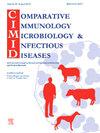Detection of Chlamydia psittaci in pet parrots sold in Xining, China
IF 2
3区 农林科学
Q4 IMMUNOLOGY
Comparative Immunology Microbiology and Infectious Diseases
Pub Date : 2025-05-29
DOI:10.1016/j.cimid.2025.102368
引用次数: 0
Abstract
Chlamydia psittaci (C. psittaci) is a zoonotic pathogen, causing a systemic wasting disease in avian as well as lung infections in humans. To evaluate the risks of psittacosis posed through pet birds, 182 fecal samples were collected from commercially popular parrot species, including budgerigars (n = 87), cockatiels (n = 28), and lovebirds (n = 67), in Xining City, northwestern China. Through molecular methods, results revealed that an overall C. psittaci prevalence of 14.3 % (26/182), while species-specific infection rates of 21.8 % (19/87) in budgerigars, 10.7 % (3/28) in cockatiels, and 6.0 % (4/67) in lovebirds. Phylogenetic analysis ompA, 16S rRNA, and 16–23S rRNA intergenic spacer (IGS) gene sequence obtained in this study confirmed that all sequences were classified to the Chlamydiaceae family and showed a high similarity to C. psittaci strains 6BC, that was previously identified in avian. This is the first documented report of C. psittaci prevalence in the pet bird markets on the Qinghai-Tibet Plateau. These findings provided an essential baseline data for understanding the epidemiology of C. psittaci in northwestern China and highlighted the need for surveillance to mitigate potential zoonotic risks.
西宁市售宠物鹦鹉鹦鹉鹦鹉热衣原体检测
鹦鹉热衣原体(C.鹦鹉热衣原体)是一种人畜共患病原体,可引起禽类全身性消耗性疾病以及人类肺部感染。为了评估宠物鸟对鹦鹉热的危害,在西宁市收集了182份商业鹦鹉的粪便样本,包括虎皮鹦鹉(n = 87)、鹦鹉(n = 28)和爱情鸟(n = 67)。结果表明,鹦鹉热感染率为14.3% %(26/182),虎皮鹦鹉感染率为21.8% %(19/87),鹦鹉感染率为10.7% %(3/28),爱鸟感染率为6.0 %(4/67)。本研究获得的ompA、16S rRNA和16-23S rRNA基因间间隔(IGS)序列的系统发育分析证实,所有序列均属于衣原体科,与先前在禽类中发现的C. psittaci菌株6BC具有高度的相似性。这是青藏高原宠物鸟市场中鹦鹉螺流行的首次文献报道。这些发现为了解中国西北地区鹦鹉螺的流行病学提供了重要的基线数据,并强调了监测以降低潜在人畜共患风险的必要性。
本文章由计算机程序翻译,如有差异,请以英文原文为准。
求助全文
约1分钟内获得全文
求助全文
来源期刊
CiteScore
4.60
自引率
0.00%
发文量
102
审稿时长
40 days
期刊介绍:
Comparative Immunology, Microbiology & Infectious Diseases aims to respond to the concept of "One Medicine" and to provide a venue for scientific exchange. Based on the concept of "Comparative Medicine" interdisciplinary cooperation between specialists in human and animal medicine is of mutual interest and benefit. Therefore, there is need to combine the respective interest of physicians, veterinarians and other health professionals for comparative studies relevant to either human or animal medicine .
The journal is open to subjects of common interest related to the immunology, immunopathology, microbiology, parasitology and epidemiology of human and animal infectious diseases, especially zoonotic infections, and animal models of human infectious diseases. The role of environmental factors in disease emergence is emphasized. CIMID is mainly focusing on applied veterinary and human medicine rather than on fundamental experimental research.

 求助内容:
求助内容: 应助结果提醒方式:
应助结果提醒方式:


